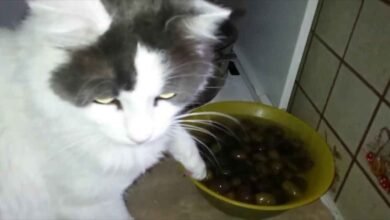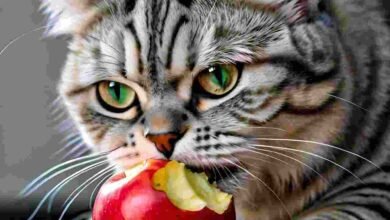Mink Cat

Mink cats are a relatively new and rare breed of cats that have gained popularity in recent years. They are known for their unique coat color and temperament. In this guide, we will explore the history, physical characteristics, temperament, health considerations, grooming needs, feeding requirements, training tips, living arrangements, common myths, and misconceptions of mink cats. We will also discuss the costs of owning a mink cat and consider the choice between adoption and buying a mink cat. Embark on this enlightening journey with us, as we uncover the allure of mink cats while prioritizing their well-being, hand in paw with CooperPetCares.
Defining Mink Cats
Mink cats are a hybrid breed that comes from the crossing of a solid-colored cat and a Siamese cat. They are called “mink” due to the unique coloration of their fur, which is reminiscent of the mink animal. Mink cats have a striking coat color that is darker on the body and lighter on the face, ears, paws, and tail.
History of Mink Cats
The history of mink cats can be traced back to the 1980s when a breeder named Paul Kelsey developed a breed called “Burmese Mink” by cross breeding Burmese cats with Siamese cats. The breed gained recognition and appreciation for its unique coat color and friendly temperament. Later on, another breeder named Margaret Heilmann developed another breed called “Tonkinese Mink” by crossing Burmese, Siamese, and Abyssinian cats.
Physical Characteristics
Coat:
Mink cats have a short and silky coat that is darker on the body and lighter on the face, ears, paws, and tail. The coloration is often described as “pointed,” resembling a Siamese cat’s coat but with a softer contrast.
Eye Color:
Mink cats typically have aqua-colored eyes, although some may have blue or green eyes depending on the breed.
Body Structure:
Mink cats have a medium-sized body with a muscular build. They are well-proportioned and have a sleek and elegant appearance.
Temperament
Mink cats are known for their friendly and sociable nature. They are intelligent and enjoy the company of humans and other pets. Mink cats are often described as playful, affectionate, and easygoing. They make excellent companions and are suitable for households with children and other pets.
Mink Cat Breeds
There are two main breeds of mink cats: Burmese Mink and Tonkinese Mink.
Burmese Mink:
This breed is a combination of Burmese and Siamese cats. Burmese Mink cats have a slightly rounded face and a more muscular body compared to Tonkinese Mink cats.
Tonkinese Mink:
This breed is a combination of Burmese, Siamese, and Abyssinian cats. Tonkinese Mink cats have a more pointed face and a longer body compared to Burmese Mink cats.
Health Considerations
Mink cats, like any other breed, may be prone to certain health issues. It is important to choose a reputable breeder who ensures the health and well-being of their cats. Some common health conditions that mink cats may be prone to include dental issues, respiratory problems, and genetic disorders such as hypertrophic cardiomyopathy (HCM).
Grooming Needs
Mink cats have a short and silky coat that requires minimal grooming. Regular brushing is recommended to maintain their coat’s health and remove loose hair. They may also benefit from occasional bathing to keep their coat clean and shiny.
Feeding Requirements
Mink cats have similar nutritional needs to other cat breeds. A balanced diet that includes high-quality cat food, preferably wet food, is recommended. Consult with your veterinarian to determine the portion sizes and the best type of food for your mink cat.
Training Tips
Mink cats are intelligent and trainable. They can be taught basic commands and tricks using positive reinforcement techniques such as treats and praise. Consistency, patience, and positive reinforcement are major factors for successful training.
Living with a Mink Cat
Suitable Environments:
Because of their adaptability, mink cats can live in any kind of environment. They are well-suited for both apartments and houses. Providing them with enough space to play and climb is beneficial.
Interaction with Other Pets:
Mink cats are generally friendly and sociable with other pets, including dogs and cats. Proper introduction and gradual socialization are important to ensure peaceful coexistence between your mink cat and other pets.
Common Myths and Misconceptions
There are several myths and misconceptions surrounding mink cats. Some people believe that mink cats are hypoallergenic, meaning they do not cause allergies. However, mink cats, like any other cat breed, do produce allergens that can trigger allergies in sensitive individuals.
Mink Cats and Allergies
If you or a family member have allergies, it is recommended to spend time with a mink cat before bringing one into your home to see if any allergic reactions occur. Allergens can be reduced with regular grooming and clean living spaces
Cost of Owning a Mink Cat
The cost of owning a mink cat varies depending on factors such as breed, pedigree, and location. Mink cats are generally more expensive than common domestic cat breeds. The price range can range from a few hundred dollars to several thousand dollars.
Adoption vs. Buying
Consider adopting a mink cat from a shelter or rescue organization. By adopting, you not only save a life but also potentially find a mink cat that perfectly suits your family and lifestyle. If you choose to buy from a breeder, make sure to research and select a reputable breeder who prioritizes the health and welfare of their cats.
Conclusion
Mink cats are a unique and beautiful breed known for their striking coat color and friendly temperament. They may be great companions for both individuals and families. By understanding their history, physical characteristics, temperament, health considerations, grooming needs, feeding requirements, training tips, and living arrangements, you will be well-prepared to welcome a mink cat into your home and provide them with a loving and nurturing environment.
Frequently Asked Questions
Are mink cats hypoallergenic?
No, mink cats are not hypoallergenic. Like any other cat breed, they produce allergens, such as dander and saliva, that can trigger allergies in sensitive individuals.
Are mink cats rare?
Yes, mink cats are considered relatively rare compared to other cat breeds. Their unique coat color and friendly temperament have contributed to their popularity in recent years, but they are still not as commonly found as more established breeds.
Do mink cats require a lot of grooming?
Mink cats have a short and silky coat that requires minimal grooming. Regular brushing is recommended to maintain their coat’s health and remove loose hair. Occasional bathing may also be beneficial to keep their coat clean and shiny.
What is the difference between Burmese Mink and Tonkinese Mink cats?
Burmese Mink cats are a combination of Burmese and Siamese, while Tonkinese Mink cats are a combination of Burmese, Siamese, and Abyssinian. Burmese Mink cats have a slightly rounded face and a more muscular body, while Tonkinese Mink cats have a more pointed face and a longer body.
Can mink cats be trained?
Yes, mink cats are intelligent and trainable. They can be taught basic commands and tricks using positive reinforcement techniques such as treats and praise.

I’m Younis, a passionate advocate for pet care and well-being. My journey in the world of writing began with a deep love for animals and a desire to share valuable information about their care and welfare.




